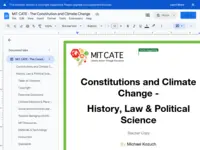https://docs.google.com/document/d/1zXfRbgroCkwh9zx7a9yRLs_63034j98ga77wrqXL2rw/edit?tab=t.0
Michael Kozuch, MIT Center for Energy and Environmental Policy Research
This learning activity takes one 60 minute class period.
Learn more about Teaching Climate Literacy and Energy Awareness»Grade Level
Regional Focus
Online Readiness
Topics
Climate Literacy
This Activity builds on the following concepts of Climate Literacy.
Click a topic below for supporting information, teaching ideas, and sample activities.
Energy Literacy
This Activity builds on the following concepts of Energy Literacy.
Click a topic below for supporting information, teaching ideas, and sample activities.
Notes From Our Reviewers
The CLEAN collection is hand-picked and rigorously reviewed for scientific accuracy and classroom effectiveness.
Read what our review team had to say about this resource below or learn more about
how CLEAN reviews teaching materials
Teaching Tips | Science | Pedagogy |
Technical Details
Teaching Tips
- Take some time to review students' homework in class to make sure they understand the structure of the constitution and the separation of powers to ensure they can fully engage with this lesson.
- As an extension, classes could discuss the rights youth to litigate and what this case shows.
- Consider including current news stories for students to think about the concepts in this lessons.
- The following social and Emotional Learning considerations are included, "The material in the "Constitution and Climate Change" slide deck may induce feelings of climate anxiety. Be sure to remind students that we are not "doomed", and there is meaningful action we can take to mitigate and adapt to climate change".
About the Content
- The activity asks students to consider whether the constitution guarantees the right to a stable environment and if so, which branch of government should take action to protect that right.
- The court case Juliana v. United States is used as a case-study with a 60-minutes excerpt and a constitution worksheet to support understanding.
- Students will use discussion to hone critical reasoning skills as it relates to using the branches of government to protect the lives and futures of citizens.
- Passed initial science review - expert science review pending.
About the Pedagogy
- A complete teacher guide and student worksheets are included in this lesson plan. Students are engaged in discussion and use a 13-minute clip and scavenger hunt activity to learn concepts.
- Students do not need to have a detailed understanding of the US government to fully participate in the activity.
- Students engage in multiple forms of feedback and discussion during the lesson, which should help to keep them engaged.
- The court case being discussed involves 11-19 year-olds, which should also be of interest.
- Teachers may want to consider a stronger assessment, or a better prompt for the assessment than what is included to "write an essay".








